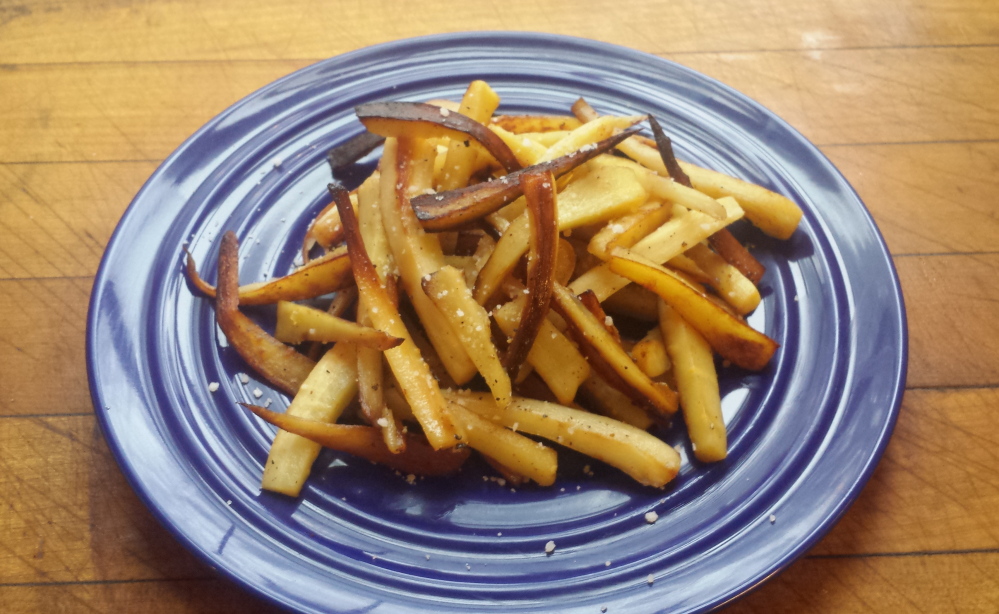On the first day of culinary school, administrators hand you a bundle of shiny new knives and you spend the first week in the kitchen cutting potatoes — first into rectangles, then 1/4-inch sticks (called batonnet), then julienned strips, and finally tiny dice (the fancy French word is brunoise).
A chef measures and weighs your cuts, looks into your waste bin and commands another round of cuts because she sees too much money in that bucket. Some chefs are more Gordon Ramsay-esque than others, but the message is consistent and constant: With razor-sharp knives at your disposal, there is no excuse for a single wasted ounce.
Culinary students learn this lesson mainly as a function of a restaurant’s bottom line, but the green angle applies. Keeping your knives as sharp as possible cuts down on food waste.
A sharp knife helps you work quickly, with precision, says David Oberton, cabinetmaker turned knife sharpener, who runs his business, Wicked Sharp, out of the South Portland home he shares with his wife, Sara (www.wickedsharpknives.com). He learned to sharpen knives while working in restaurants in Germany in the 1970s, continued the practice for friends and family, honed his skills under the tutelage of a master sharpener, and eventually hung his own shingle.
Five years ago, looking to expand his customer base, he followed a trend in which itinerant sharpeners set up shop at farmers markets, and he landed a twice-monthly spot in the Brunswick Winter Farmers Market. He now participates in that market weekly, sets up every other Friday at Whole Foods in Portland, and goes to the Sunday market in Lewiston once a month. Customers drop dull knives with him, shop and then pick up sharp ones when they leave the market.
“Many people who come by admit to having a drawer full of dull, retired knives,” Oberton said. “We make them usable again.” On average, he sharpens 70 knives, first on a wet wheel to get a “raised wire edge” and then over a diamond wheel to hone them. Knives with damaged tips and uneven blades require more work on a leather belt. He also sharpens scissors and garden tools.
To keep your knives sharp, Oberton says to use them only for their intended purpose and never to cut frozen foods. Also, employ wooden or kitchen-safe plastic cutting boards, wash and dry knives by hand and store them in a sleeve (which he provides with each sharpening), on a hanging magnetic strip or in a knife block.
A sharp knife makes food look and taste better because a sharp blade will damage fewer flavor-containing cells in whatever is on the chopping block than a dull one will. As a green-minded cook, little to no waste is a beneficial by-product.
CARAMELIZED PARSNIPS
Sara Oberton has plenty of sharp knives in her kitchen, no surprise. In this recipe, she deftly cuts sweet winter parsnips into shapes that her grandchildren think are french fries.
Serves 4
1 pound parsnips, peeled and ends trimmed
2 tablespoons butter
1/8 teaspoon freshly grated nutmeg
Salt and pepper, to taste
After peeling the parsnips, cut into sticks that are the size of large french fries. Dry off any moisture with a paper towel or cloth. Melt the butter in a skillet over medium heat and add the parsnips, tossing to coat. Sprinkle with nutmeg.
Cover the skillet tightly with a lid. Cook over medium heat until the parsnips are golden brown, about 10 minutes.
Add 2 tablespoons water, re-cover the pan and steam until the water has evaporated and parsnips are golden, tender and caramelized.
Season with salt and pepper.
Christine Burns Rudalevige is a food writer, recipe developer and tester, and cooking teacher in Brunswick. She writes about feeding her family Maine seafood at familyfish.net. Contact her at cburns1227@gmail.com.
Copy the Story LinkSend questions/comments to the editors.



Success. Please wait for the page to reload. If the page does not reload within 5 seconds, please refresh the page.
Enter your email and password to access comments.
Hi, to comment on stories you must . This profile is in addition to your subscription and website login.
Already have a commenting profile? .
Invalid username/password.
Please check your email to confirm and complete your registration.
Only subscribers are eligible to post comments. Please subscribe or login first for digital access. Here’s why.
Use the form below to reset your password. When you've submitted your account email, we will send an email with a reset code.